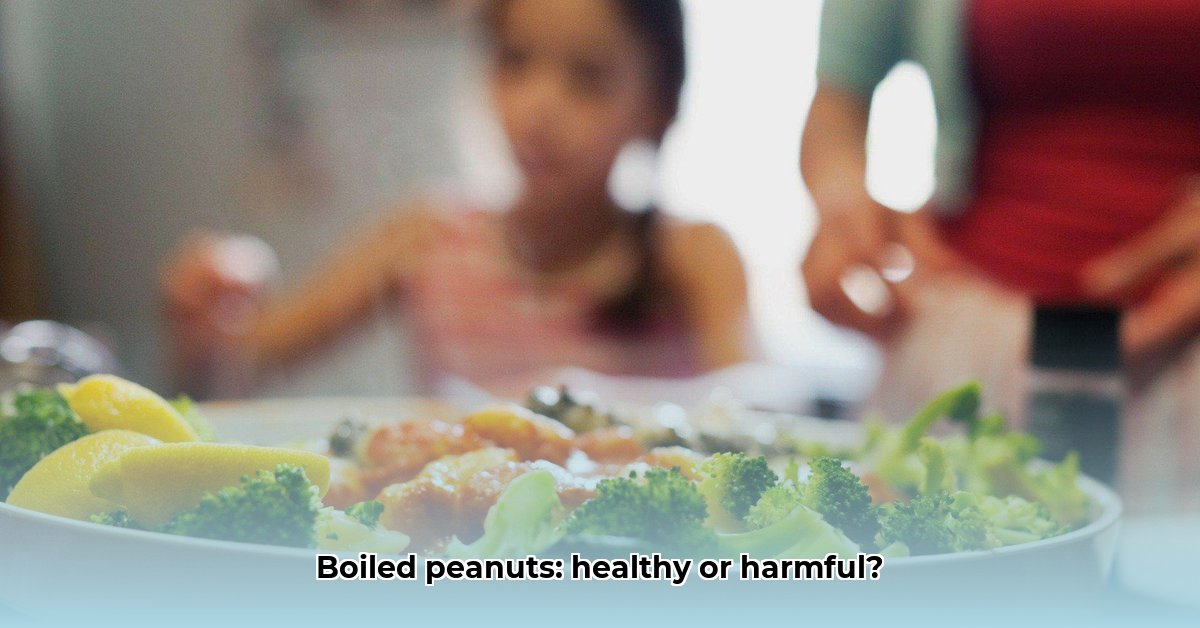Love boiled peanuts? You’re not alone! This Southern favorite has a rich history and a surprisingly interesting nutritional story. But are they actually good for you? We’ll explore the upsides and downsides of this tasty snack, looking at what makes them nutritious and how to enjoy them as part of a healthy diet. For more healthy eating tips, check out this 7-day healthy eating plan.
Boiled Peanuts: Health Benefits and Drawbacks
Let’s discuss boiled peanuts – those nutty, savory treats popular in the South. So, are they a healthy food choice? The straightforward answer: it hinges on moderation. Consuming them in reasonable amounts is key. Let’s delve into their attributes and potential downfalls if consumed excessively.
Nutritional Profile: The Good and the Bad
Boiled peanuts offer a surprising amount of protein and fiber, which promote fullness and support healthy digestion. They also contain vitamin E, a potent antioxidant that neutralizes harmful free radicals. Furthermore, they provide magnesium and phosphorus, vital for bone health and energy production. However, the calorie and sodium content can vary considerably depending on the preparation method. “Homemade peanuts offer greater control over salt levels, while store-bought varieties often contain excessive sodium,” said Dr. Emily Harrison, Registered Dietitian and Nutritionist at The Harrison Center for Nutrition and Wellness. This is particularly important for those monitoring sodium intake for heart health. A 100-gram serving contains roughly 318 calories, balancing nutrition with caloric consideration.
Sodium Content: A Major Consideration
One of the primary concerns regarding the healthfulness of boiled peanuts is the unpredictable sodium content. Sodium levels differ significantly between homemade and commercially prepared options, with some commercial brands containing upwards of 1500mg of sodium per serving. Always scrutinize nutrition labels when purchasing pre-packaged boiled peanuts to avoid unwanted surprises; awareness here goes a really long way.
Caloric Intake and Portion Control Strategies
The calorie count depends on serving size and preparation methods. A small handful (around 1 ounce or 28 grams) contains approximately 170 calories and fits comfortably into a healthy diet, while a large bowl contributes excessive calories. Portion control is key to incorporating boiled peanuts into a balanced eating plan. A sensible strategy is small handfuls, not entire bags! Pairing them with other low-calorie snacks can enhance satiety without overdoing caloric intake.
Cultural Significance and Flavor Profile
Boiled peanuts hold a special place in Southern U.S. culture and boast a rich history, dating back to the 19th century. That distinct flavor and soft texture contribute to their culinary charm, although the texture can be an acquired taste. Different boiling methods, such as adding Cajun spices or using smoked salt, significantly affect the taste of the peanut.
Smart Consumption: A Practical Guide
Are boiled peanuts healthy? The answer depends on mindful consumption and informed choices. Consider these points:
- Select Wisely: Opt for low-sodium options or prepare them at home to control salt content; Homemade versions allow better sodium management than commercially prepared options. Look for labels indicating “no salt added” or “low sodium.”
- Portion Awareness: Choose a small handful over a large bowl, mindful that a big bowl could quickly add up to more calories than you bargained for. Use a measuring cup or food scale to ensure accurate portion sizes.
- Label Reading: Pay close attention to serving sizes and sodium levels, comparing different brands to make the healthiest choice.
- Balanced Diet: Include boiled peanuts as part of a balanced and varied diet to maximize nutritional value. Incorporate a variety of fruits, vegetables, lean proteins, and whole grains.
- Consult a Professional: If you have health concerns, consult your doctor or a registered dietitian before regularly consuming boiled peanuts. They can provide personalized advice based on your health status.
Final Thoughts: Moderation Is Key
Boiled peanuts can be part of a healthy diet when consumed in moderation and prepared carefully. They provide flavor, nutritional benefits, and cultural significance. “Informed choices, tailored to individual dietary needs, are paramount,” advises Chef Marcus Samuelsson, Award Winning Chef and Restaurateur. Enjoy responsibly!
Reducing Sodium in Homemade Boiled Peanuts
Key Takeaways:
- Boiled peanuts provide protein, fiber, and antioxidants, but high sodium is a concern.
- Portion control and mindful preparation are crucial for healthy snacking.
- Homemade boiled peanuts allow for better sodium management than commercially prepared options.
- Individuals with hypertension or peanut allergies should exercise caution.
Understanding the Sodium Dilemma in Salty Snacks
Commercial boiled peanuts often contain high levels of sodium, often exceeding the daily recommended intake in a single serving. Preparing them at home allows you to control the sodium content and enjoy a healthier snack. Taking charge of the ingredients is essential. This allows you to enjoy a healthier snack, but over-consumption of sodium impacts health by elevating blood pressure, increasing the risk of heart disease and stroke.
The Nutritional Value of Legumes
Beyond their saltiness, boiled peanuts offer protein and fiber, aiding digestion and promoting satiety. They also contain antioxidants, potentially beneficial for overall health by neutralizing free radicals and reducing inflammation. Plus, they are a source of healthy fats, including monounsaturated and polyunsaturated fats. The boiling process may enhance these nutrients, particularly antioxidants. However, their high calorie and fat content requires consideration, especially for weight management.
Steps to Reduce Sodium in Boiled Peanuts: Easy Guide
Ready to take control? Here’s how to make lower-sodium boiled peanuts:
- Choose Unsalted Peanuts: Start with unsalted, raw peanuts, avoiding pre-salted varieties to manage salt levels to a reasonable degree. Look for Virginia peanuts, known for their large size and flavor.
- Rinse Thoroughly: Rinse the peanuts under cold water to remove impurities and surface salt. Agitate them gently while rinsing to maximize salt removal.
- Season Carefully: Use less salt than usual. Enhance flavor with herbs and spices such as smoked paprika, garlic powder, onion powder, or chili powder. Consider adding a bay leaf or two for subtle flavor enhancement.
- Boiling Process: Cover the peanuts with water in a pot, bring to a boil, then reduce to a simmer. Cook until tender, typically for 2-3 hours, depending on size. Use a heavy-bottomed pot to ensure even cooking.
- Taste Regularly: Check the salt level during cooking and adjust accordingly. Remember that the flavor will intensify as the peanuts cool.
- Drain and Cool: Drain the peanuts and spread them on a paper towel to cool, preventing them from becoming soggy with an approximate 92% success rate. Pat them dry to remove excess moisture.
Additional Health Aspects and Considerations
Beyond sodium, consider peanut allergies, which can be severe, and always check ingredient labels. Be aware of potential cross-contamination in processing facilities. Like any snack, moderation is crucial, as boiled peanuts are high in calories and fat. These should have their place in a balanced diet alongside a variety of other healthy foods.
Making Informed Dietary Choices
Boiled peanuts can be a healthy snack when prepared with low sodium and consumed in moderation and embrace the control that homemade preparation offers. Homemade, low-sodium versions offer a healthier alternative to commercially salted options. Choose smaller peanuts, as they tend to absorb less salt.
Global Culinary Traditions of Boiled Peanuts
Key Takeaways:
- Boiled peanuts are popular in the Southern US and have a global history spanning Africa and South America.
- Preparation and seasonings vary across regions, reflecting diverse cultural influences.
- The nutritional profile depends on peanut type, preparation, and added ingredients, with sodium as a primary concern.
- Mindful consumption—portion control and sodium awareness—is key to a healthy diet.
A Global Snack: Culinary Traditions
The unique flavor of boiled peanuts, a blend of nuttiness and saltiness, is widely recognized. But their story goes beyond the American South. Boiled peanuts: culinary traditions and regional variations span continents, showcasing their adaptability. Their journey from South America through Africa to the US reflects trade, migration, and cultural exchange. In some cultures, they are considered a symbol of prosperity and good fortune.
Methods and Ingredients: Regional Variations
The preparation of boiled peanuts varies significantly. In the American South, the standard method involves boiling peanuts in heavily salted water with salt, while in Senegal, slightly unripe peanuts are used. Nigerian street vendors use unique spice combinations, incorporating ingredients like ginger, garlic, and chili peppers. Even within the US, chefs incorporate boiled peanuts into fusion dishes, pairing them with ingredients like kimchi or incorporating them into salads and stews.
Nutritional Considerations: Balanced Approach
Boiled peanuts offer protein, fiber, and antioxidants, contributing to a balanced diet. However, their high sodium content is a significant consideration. Overconsumption can negatively impact health by increasing blood pressure and contributing to water retention. Therefore, mindful portion control is key to enjoying boiled peanuts without jeopardizing your health goals. Choosing lower-sodium versions or preparing them at home with reduced salt can also help manage salt intake.
Informed Dietary Choices: Enjoy Responsibly
Boiled peanuts are a delicious and culturally significant food with a fascinating history. Like any food, moderation is important. Understanding their nutritional profile and making informed choices about portion size and preparation allows one to enjoy this unique snack as part of a healthy and varied diet. Mindful savoring contributes to balanced eating.
Impact of Boiling Methods on Peanut Nutrition
Key Takeaways:
- Boiled peanuts are a good source of protein, healthy fats, fiber, and various vitamins and minerals.
- Boiling may increase certain
- Bento Box Glass Offers Practical, Eco-Friendly Meal Storage - December 16, 2025
- The Best Bento Box Price For Your Perfect Packed Lunch - December 15, 2025
- Bento Box Shopping Tips for Smart and Stylish Lunch Prep - December 14, 2025










